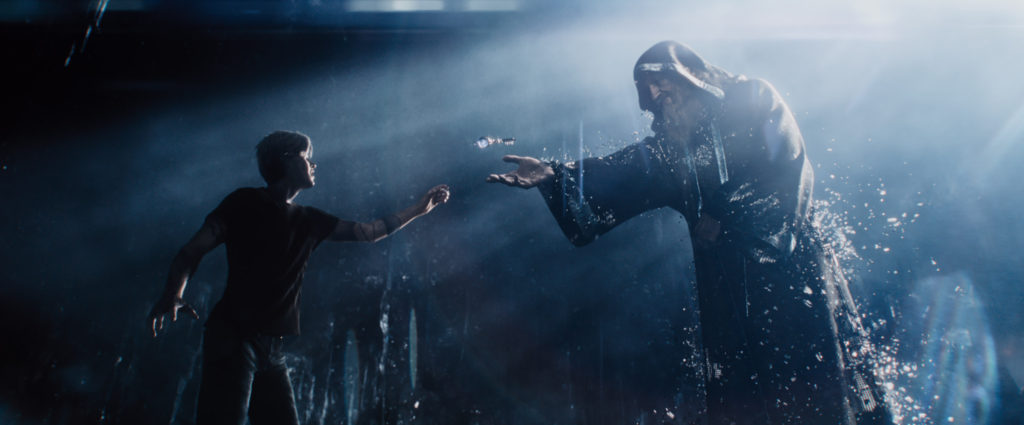I spent much of my childhood entertained by pop culture’s endless commodities. They made me happy — being introduced to the worlds of Pokemon, Teenage Mutant Ninja Turtles, Super Mario Bros. and Disney’s classic animated films.
The world of film made the biggest impact on my life in terms of who I am as a person today. The great director Steven Spielberg had a lot to do with that.
As far as choices for directors to guide the pop culture filled book “Ready Player One,” Spielberg was the best. Hell, he helped create and pave the way for many of the references and characters that were in the book. And what he did with putting it on the big screen was a marvel of cinematic nostalgia.
However, as beautiful as what Spielberg puts on screen is, little flaws here and there leave me wanting more of the original dense material.
In “Ready Player One,” teenager Wade Watts (Tye Sheridan) is living in torn-down 2045 Chicago where everyone is connected to the only thing that helps them escape from this desolate world: the Ontologically Anthropocentric Sensory Immersive Simulation (OASIS). The OASIS is a virtual universe in which anybody can be anything.
After the creator died, an announcement of his virtual self was spread to the world. He said that there are three hidden keys to collect in the virtual universe. The first person to collect the keys are given a dense fortune and ownership of the OASIS.
Wade found the first key but enlists help of some fellow players to find the other keys before a sinister company called Innovative Online Industries (IOI), led by Nolan Sorrento (Ben Mendesohn), collects all three keys and regulates and ruins the OASIS.
Imagine yourself creating a character of your own. You can be anyone or anything, even Darth Vader or Batman or Yoshi. Your character can interact with anyone and anything in this virtual universe. Doesn’t this sound fun?
It’d only be fun if the Iron Giant could fight Mechagodzilla. That happens? Oh damn!
This is the OASIS. You can generate a personality of pop culture into the game and control them via virtual reality.
I loved all the Easter eggs or hidden, unexpected bonuses that weren’t featured as a main characteristic of a medium. Fortunately, I will have to watch it again and again to catch all the characters and actions jam-packed into “Ready Player One.”
Aside from the nostalgic references, I could not help but smile all the way through “Ready Player One” because I realized that Spielberg is coming back to his roots of whimsy and awe.
Remember the first time you saw “Jurassic Park” and Doctor Grant grabbed Ellie’s head as she was rambling in a truck to face a brontosaurus reaching for leaves and branches in a tall tree while John Williams’ legendary score played?
“Ready Player One” had a similar effect on me when I first got a glimpse of the Oasis.
The special effects going back and forth to the real world and the OASIS was, for me, what seemed like it could have been difficult. As Spielberg does, he proves me wrong and makes it seamless. I was completely mesmerized by the CGI. It was fast paced and video game-like with the believability of an end to a world that people care about.
Although the main component to make “Ready Player One” the pop culture epic it’s become was the OASIS itself, not as much of the real world was shown to portray real world problems.
One problem I wish was addressed in the film was how the transition from today’s society to a dead-beat and miserable future was shaped. There were so many people — as much as half the world — that became entirely invested, almost addicted, in the virtual universe James Halliday, creator of the OASIS, built, but no context was given.
Little questions about the background of what the near future came to be struck my mind here and there. Still, I could feel my imagination expanding watching Wade Watts use his avatar Parzival to search for the three Easter eggs.
In terms of narrative and movement of the plot, I was satisfied. Each act was truly better than the next. In the second act, there is a scene in which Watts as Parzival and his gang go through a classic horror movie that had me hooked once the film was first mentioned.
As niche as these references and characters might sound to some people, there is no denying that pop culture has formed or shaped your imagination in one way or another. And what better way to portray a conglomerate of icons we interact with every day in film than to hire the person who has created many of these characters.
“You’re gonna need a bigger boat.”
“E.T. phone home.”
“Life will find a way.”
“I think it pisses God off when you walk by the color purple in a field and don’t notice it.”
“Earn it.”
Chances are, you know one of these quotes. Even if you haven’t seen one of his films, you know something about them. This is the impact that Spielberg has made in pop culture. I mean, Jaws was the first big summer blockbuster ever made. Spielberg has shown audiences time after time that film is something to have fun with while also telling a story; that is art.
“Ready Player One” brought back the playfulness of Spielberg’s films like “E.T.” but it also heeds the warnings of humans being attached to technology. It tells a universal story that its director has created to manipulate the audience — in a good way — to feel and to change.
Here’s hoping that “Ready Player One” will stay in my top ten movies of 2018 for the pure fun and imagination.








